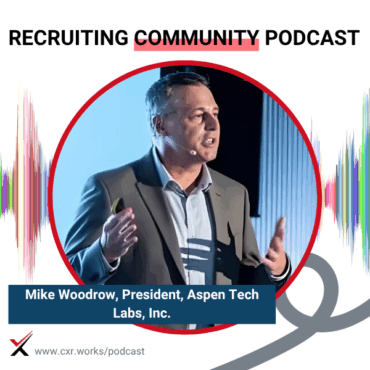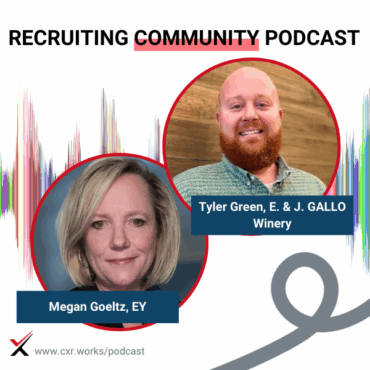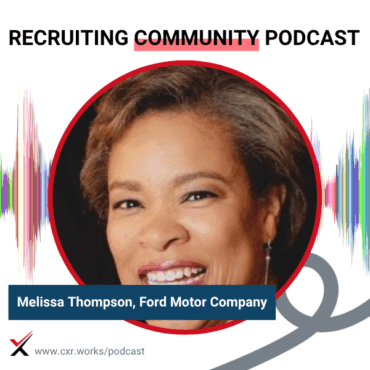
Re-calibrating Your Talent Acquisition Teams
What does a TA transformation look like at a legacy company like Ford? Melissa Thompson breaks down how redesign, reimagine, and rethink are reshaping hiring.
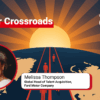 play_arrow
play_arrow
Balancing Strategy and Tactics: Melissa Thompson’s Career Crossroads Cami Grace
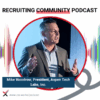 play_arrow
play_arrow
Real-Time Jobs Data and the TA Advantage Cami Grace
 play_arrow
play_arrow
20+ Years at Dell and Beyond: Jennifer Newbill’s Career Crossroads Cami Grace
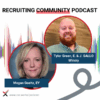 play_arrow
play_arrow
AI Interview Research Cami Grace

Episode Overview:
Jason Putnam, CRO of Plum, discusses the significant role of organizational culture and its impact on business and employee engagement. Jason will highlight Plum’s innovative approach to blending hard and soft skills in their platform, and introduced their new culture gap analysis tool.
Key Topics Covered:
Organizational Culture: Discussion on whether culture is a business or a moral objective, with insights into how companies can align their cultural perceptions across different levels of the organization.
Plum’s Innovations: Introduction of a platform that combines hard and soft skills, and a culture gap analysis to help organizations align their culture with their strategic goals.
Importance of Cultural Fit: Exploration of how culture drives business success and the importance of aligning employee and employer cultural expectations.
Closing Notes:
The discussion underscored the pivotal role of culture in organizational success and employee satisfaction. Jason Putnam’s insights highlighted the necessity of understanding and bridging cultural gaps within companies to foster a supportive and successful workplace environment. The episode concluded with a call to action for listeners to consider how they can contribute to creating a positive organizational culture.
Title:
The Culture Gap
Featured Guests:
Jason Putnam, Chief Revenue Officer, Plum
Hosts:
Chris Hoyt
Gerry Crispin
Episode Overview:
Jason Putnam returns to the CXR Recruiting Community Podcast to share insights on Plum’s latest platform expansion—combining soft and hard skills with a new culture gap analysis. The discussion explores the tension between leadership’s vision of culture and employees’ lived experiences, and how data can align those perspectives to drive business results. The episode also addresses how real cultural awareness fuels retention, transformation, and enterprise performance.
Key Topics:
Plum’s platform updates: combining hard and soft skills + culture analytics
The three-sided culture model: executive vision, employee perception, and employee aspiration
Culture as a strategic imperative vs. a top-down directive
Case study: Using culture data in a $2B HR transformation project
Challenges with executive ego and misalignment
Democratizing psychometric data and enhancing the individual experience
Talent management applications beyond selection—leadership development, succession planning
Notable Quotes:
“Culture is not good or bad—it’s about alignment.” — Jason Putnam
“We don’t want customers who don’t want to know the truth about their culture.” — Jason Putnam
“It’s not about pulling people to your vision—it’s about meeting them where they are.” — Jason Putnam
“Get It Right, Stupid.” — Jason Putnam
“We’re truly democratizing psychometric data.” — Jason Putnam
Takeaways:
Organizational culture becomes a liability or an asset depending on how well it’s understood and aligned across levels. Jason Putnam emphasizes that when companies use data to close the gap between leadership’s vision and employee experience, they not only reduce attrition and resistance to change—they unlock high performance and engagement. Culture isn’t fixed—it’s an evolving, strategic lever.
Want more conversations like this?
Subscribe to the CXR podcast and explore how top talent leaders are shaping the future of recruiting. Learn more about the CareerXroads community at cxr.works.
Chris Hoyt: I know it’s where I’ve—so I’ve been on the road. Jerry, I think we’ve been on the road four weeks in a row.
Gerry Crispin: Yep. It’s like old times.
Chris Hoyt: Yeah, it’s like old school.
Jason Putnam: I think I’ve seen you almost all of those four weeks, or at least virtually, if not live.
Chris Hoyt: We did! Jerry was here in Austin for ERE, which had probably one of the strongest agendas I’ve seen at an ERE, especially when you put it up against some of the other big ones. Lots of heads of TA and directors telling good stories and making great connections. It was a good event. But we saw you—we saw you at dinner.
Jason Putnam: Yes, and Unleash.
Chris Hoyt: And now it’s been a lot.
Jason Putnam: Yeah, round and around.
Chris Hoyt: Do you have anything next? I’m trying—NACE is in two weeks for me.
Jason Putnam: For me, I’m speaking in Nashville next week at a Future of Work in Transportation group, which is pretty interesting. Then Michelle and I are speaking together on stage at TAtech at the Spy Museum in DC.
Chris Hoyt: Oh, that’s a fun spot.
Jason Putnam: And I think we’re doing Unleash UK—we’re just going as attendees. But yeah, a lot of travel. Then I’ll be in Canada for eight days—we take the whole company offsite for a week, which is great.
Chris Hoyt: That’ll be fun. Well, we’ve got some fun stuff to talk about today—and it hit the news a little while ago too, so as timing would have it, this’ll be a fun chat. You guys ready to get started?
Jason Putnam: Absolutely.
Gerry Crispin: Yep.
Chris Hoyt: All right. Let’s talk about culture.
Announcer: CXR channel, our premier podcast for talent acquisition and talent management. Listen in as the CXR community discusses a wide range of topics focused on attracting, engaging, and retaining the best talent. We’re glad you’re here.
Chris Hoyt: There we go. Everything seems to be working. Jerry, I can even see you. All right, welcome to the Recruiting Community Podcast. We like to say we’re bringing you weekly insights and updates in the form of a conversation. I’m your host, Steve Jobs. This is my co-host, Steve Wozniak. Woz, how are you, my man?
Gerry Crispin: Nothing. Uh, just fine.
Chris Hoyt: Were you Rolodexing Steve Wozniak?
Gerry Crispin: No, I know Steve Wozniak, actually. Some of the others you’ll have to help me with. But yeah, that’s an easy one.
Chris Hoyt: Well, look—we’ve got Jason Putnam here today. He’s the CRO for Plum. He’s back—it’s not his first time on the show—and he’s gonna bring an interesting question for us to discuss.
People argue that culture is either a business objective or a moral objective. We’re asking, which is more accurate? And what might bridge the gap? And what happens if you don’t?
A few things first—just as a reminder, we’re streaming on YouTube, Facebook, LinkedIn… this week, I think we’re also on Twitch and maybe TikTok, I can’t remember. But wherever you want to listen, head to cxr.org/podcasts. You can see future episodes coming up, and of course, catch any of the past ones.
If you’re joining us on LinkedIn, the chat window is open. Say hello. If you’ve got a question or a point to make—or just want to fan out—you can drop a note there.
Jerry, from a housekeeping perspective, we’ve got a little QR code in the bottom of the screen. What’s that mean?
Gerry Crispin: That’s for our foundation—our 501(c)(3). And I think we’re on a good roll with it. We’ve got history, scholarships, a whole host of things we offer through the foundation.
Chris Hoyt: A hundred percent. We’ve raised almost $34,000 this year for two individual scholarships. They go out to families and members of the TA community. That’s the Inspire Scholarship and the Rest Mountain Scholarship.
We’ve also got the History of TA that Jerry mentioned. That’s a lot of fun work being done. CXR Cares, and even a board seat open. If you’re interested, go to cxrfoundation.org—or if you want to make a donation, you can scan the QR code on the screen.
With that, our PSA is done. Let’s bring in Jason. Jason, how are you?
Jason Putnam: Good. I’ll take the hot seat. Nice to see you guys again—four weeks in a row.
Chris Hoyt: It does work that way, yeah. Okay, so not an elephant, but we’ve got a rhino in the room—because just a few hours before we connected today, you had an announcement, a little presser, about Plum. Start by giving us the elevator pitch—who is Jason Putnam, and why should we be listening to you today? Then let’s talk about what’s going on at Plum.
Jason Putnam: Sure. I’m much better talking about Plum than myself, but I’ll give it a shot.
I’ve been doing this for a long time—at a similar level in our industry. Prior to here, I was CRO at Pandologic. Before that, CRO at BountyJobs. I’ve worked at similar levels in fintech and manufacturing tech, but I started in this space, went away like most of us do, and came back.
On the Plum side, especially in the last two and a half years, most people have heard of us. We’re a science-backed company, and what we did was take something very predictive—psychometric data, or soft skills—and figured out how to make that data accessible and useful for both humans and enterprises.
We’ve grown a lot—about 230–240% in a down market, which is impressive. Most of our clients are large enterprises using Plum data not only for selection but all the way through talent management—succession planning, leadership potential, etc.
What we noticed is that people actually like Plum. We get about 50,000 people a month creating their Plum profile. Some are applicants, some are employees, but around 20% are completely organic—just coming to learn more about themselves. That’s been a big sign for us that we’re truly democratizing psychometric data.
What we announced today is that we’ve now combined soft skills with hard skills in one platform. We’ve also rolled out a culture gap analysis—but only on the talent management side, not for selection.
So now it’s a 360-degree view of talent for employers—and we’re also doubling down on the individual experience. People can update their skills, indicate aspirational roles, and get career coaching and pathing. About 70% of our monthly new users are under 30. Some are new grads, others are changing careers.
Chris Hoyt: It’s a big announcement, and I think it fits nicely with today’s discussion on culture. So Jason, let’s start with a definition. How do you define culture within an organization?
Jason Putnam: It’s a tough question—everyone has a different answer. I look at it through the lens of a CEO. The CEO has to ensure the company is accomplishing three things:
Meeting fiduciary responsibilities—revenue, capital.
Ensuring people are safe and growing.
Establishing the right culture.
Culture looks different at different companies. A call center’s culture isn’t the same as a lifestyle brand’s culture. So we approached this by building a culture gap analysis.
In a perfect world, culture is like a Venn diagram: executives define what the culture is or should be; employees perceive what it is; and employees also have aspirations for what they want it to be. Ideally, those three overlap. What we’ve found is they often don’t.
Our platform helps expose those gaps. Rather than executives pulling people toward their version of culture, we help them understand where the workforce already is—and align the business in that direction. It’s all about alignment.
Chris Hoyt: So when you talk about that “get on the bus or get under it” culture, I immediately think of someone like Jamie Dimon. That kind of leadership takes a stance—this is how the company runs, and if you don’t like it, get out.
It must be a special kind of leader you’re working with who realizes that there’s a gap between how leadership sees culture and how employees experience it.
Jason Putnam: Yeah, and we’ve had people ask us, “What if the C-suite doesn’t want to know what the employees think the culture is?” Then we don’t want them as a customer.
The Jamie Dimon example—or Elon Musk—is great. Some of us might look at those cultures and say, “That’s toxic.” But people work there and love it. So it’s not about good or bad culture—it’s about knowing the gap and managing it.
Chris Hoyt: So what’s the business impact when you close that gap? What’s the measurable change?
Jason Putnam: I’ll give you an example. One of our beta clients—a huge healthcare company—has a $2 billion HR transformation underway. They brought in Plum early to capture the data.
They used our culture and talent data to identify early adopters—those most open to change. Then they identified people in that group with leadership potential to bring others along. It turned their change management into a cohort strategy instead of just blasting the whole org with the same approach.
Chris Hoyt: That makes sense. But have you encountered any mini-Dimons? Leaders who say, “This is the culture I want, and we’re going that way regardless”?
Jason Putnam: More than I’d like to say. Not our current customers, but in early conversations—maybe half the CEOs we talk to want people to kneel and kiss the ring. They don’t see that changing the culture to align with employees might actually make them more money.
Chris Hoyt: We ask this of every guest: if you were going to write a book about the state of culture in organizations, what would the title be?
Jason Putnam: “Get It Right, Stupid.”
We ran our own culture gap analysis at Plum. The overlap was tight. We’re small, but we have high alignment between what leadership wants and what employees experience. That culture fuels our performance.
Chris Hoyt: Have you already given that title some thought?
Jason Putnam: Nope. That was on the fly.
Chris Hoyt: Who gets the first signed copy?
Jason Putnam: My wife—out of obligation. She’ll probably be the one to edit it anyway.
Chris Hoyt: That’s fair. Jason, always great to have you on. And thank you—that offer to match donations today up to $1,000 to the CXR Foundation is incredibly generous.
Jason Putnam: Happy to do it. Appreciate all the support.
Chris Hoyt: Reminder to everyone—visit cxrfoundation.org. If you’re on the treadmill, scan that QR code on screen.
Also, in June, we’ve got a full day of live streaming—seven hours of product demos, interviews, and walkthroughs. It’s going to be a telethon of talent solutions. More info at cxr.works.
Jason, thanks again. Let’s say goodbye to everyone.
Jason Putnam: Thank you all for having me. Appreciate the support.
Announcer: Thanks for listening to the CXR channel. Please subscribe to CXR on your favorite podcast platform and leave us a review while you’re at it. Learn more about CXR at cxr.works and follow us on social media at CareerXroads. We’ll catch you next time.
Tagged as: Podcast, employee engagement, workplace culture, Leadership.
Chris Hoyt is the President of CareerXroads, a global peer community for talent acquisition leaders driving strategic change. With decades of experience leading recruiting innovation at Fortune 500 companies, Chris now advises enterprise TA teams on tech, process, and leadership. He’s a frequent speaker at conferences like SHRM, HR Tech, LinkedIn, and UNLEASH, and he’s known for pushing conversations beyond buzzwords to get to what really works in hiring. Through CXR, he connects top TA professionals to solve real problems, challenge norms, and shape the future of recruiting.

What does a TA transformation look like at a legacy company like Ford? Melissa Thompson breaks down how redesign, reimagine, and rethink are reshaping hiring.
